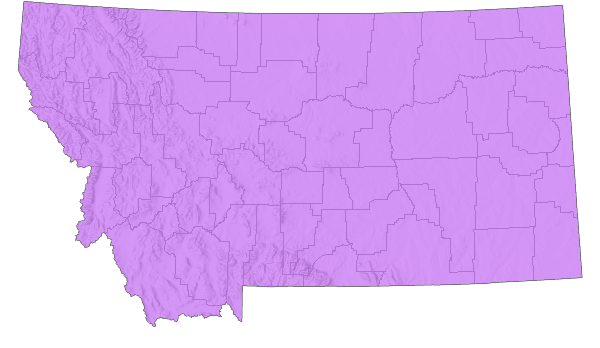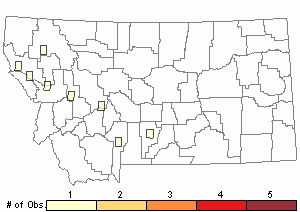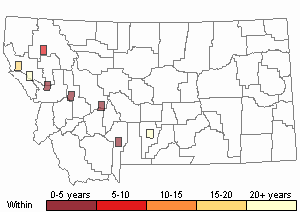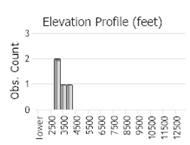View in other NatureServe Network Field Guides
NatureServe
Montana
Utah
Wyoming
Idaho
Wisconsin
British Columbia
South Carolina
Yukon
California
New York
Short-winged Toothpick Grasshopper - Pseudopomala brachyptera
Other Names:
Bunch Grass Locust
General Description
The following is taken from Brooks,(1958), Helfer,(1971), Otte (1970, 1981), Capinera and Sechrist (1982), Vickery and Kevan (1985), McDaniel (1987), Capinera et al. (2004), Brust et al. (2008), and Scott (2010). A medium size grasshopper with a strongly slanted face and strongly sword-shaped (ensiform) antennae. The wings (tegmina) are short and taper to an acute tip. Body color light brown or pale gray (males usually brown, females gray). Faint stripes occur on the lateral sides of the head, pronotum and onto the forewings but sometimes stripes are broken or absent. The legs are long and slender. This species singing (stridulation) is easily heard in the field with a series of ten to twenty individual leg strokes producing sh-sh-sh-sh sounds of increasing intensity.
Phenology
Probably overwinters in nymph stage since both nymphs and adults can be found in the fall. They appear in May, and adults occur from June to September, sometimes into October (Hebard 1928, Brooks 1958, Capinera and Sechrist 1982, Otte 1984, Vickery and Kevan 1985, Capinera et al. 2004, and Scott 2010).
Diagnostic Characteristics
The following is taken from Brooks (1958), Helfer (1971), Otte (1981), Capinera and Sechrist (1982), Vickery and Kevan (1985), McDaniel (1987), Capinera et al. (2004), Brust et al. (2008), and Scott (2010). Male body length is 23 mm to 27 mm, and females 27 mm to 35 mm. Hind tibia is brown or reddish-brown and has more than 15 spines. The top of the head (vertex) is elongate, bluntly rounded, and projects beyond the eyes by nearly twice the eye length.
Only other species that could possibly be confused with this species would be the
Two-striped Mermiria Grasshopper (
Mermiria bivittata). It is larger, lacks the strongly slanted face and is much more boldly striped.
Species Range
Montana Range
Range Descriptions

 Native
Native
Range Comments
This is essentially a northern species, distributed from the New England states westward to eastern Washington and Oregon, and from British Columbia, Alberta, and Saskatchewan, southward to Oklahoma. In Montana, it has been reported for 7 counties (Hebard 1928, Brooks 1958, Capinera and Sechrist 1982, Otte 1984, Vickery and Kevan 1985, Brust et al. 2008, Capinera et al. 2004, and Scott 2010).
Observations in Montana Natural Heritage Program Database
Number of Observations: 49
(Click on the following maps and charts to see full sized version)
Map Help and Descriptions
Relative Density

Recency



 (Observations spanning multiple months or years are excluded from time charts)
(Observations spanning multiple months or years are excluded from time charts)
Habitat
This species can be found in a variety of habitats but prefers open areas of tall bunch grasses. Other favored habitats include edges of wooded areas, and streams and ponds (Vickery and Kevan 1985, Otte 1984, Brust et al. 2008).
Food Habits
Feeds on a variety of grasses and sedges including
little bluestem (
Schizachyrium scoparium),
blue gramma (
Bouteloua gracilis),
foxtail barley (
Hordeum jubatum),
switchgrass (
Panicum virgatum),
prairie cordgrass (
Spartina pectinata),
Kentucky bluegrass (
Poa pratensis), and
Canada bluegrass (
Poa compressa) (Brust et al. 2008).
Reproductive Characteristics
A courting male approaches a female slowly, stopping frequently, and singing one or more songs each time he stops. He rushes toward the female, stridulating with longer and slower pulses and mounts the female. Information and observations have not been made regarding egg laying, number of nymphal instar stages, and other reproductive characteristics (Otte 1970).
Stewardship Responsibility
References
- Literature Cited AboveLegend:
 View Online Publication
View Online Publication Brooks, A.R. 1958. Acridoidea of Southern Alberta, Saskatchewan, and Manitoba (Orthoptera). The Canadian Entomologist (Supplement 9) 90:5-92.
Brooks, A.R. 1958. Acridoidea of Southern Alberta, Saskatchewan, and Manitoba (Orthoptera). The Canadian Entomologist (Supplement 9) 90:5-92. Brust, M.L, W.W. Hoback, and R.J. Wright. 2008. The Grasshoppers of Nebraska. Lincoln, NB: University of Nebraska Extension Service, APHIS.
Brust, M.L, W.W. Hoback, and R.J. Wright. 2008. The Grasshoppers of Nebraska. Lincoln, NB: University of Nebraska Extension Service, APHIS. Capinera, J.L. and T.S. Sechrist. 1982. Grasshoppers of Colorado: Identification, Biology, and Management. Fort Collins, CO: Colorado State University Experiment Station, Bulletin 584S. 161 p.
Capinera, J.L. and T.S. Sechrist. 1982. Grasshoppers of Colorado: Identification, Biology, and Management. Fort Collins, CO: Colorado State University Experiment Station, Bulletin 584S. 161 p. Capinera, J.L., R.D. Scott, and T.J. Walker. 2004. Field Guide to Grasshoppers, Katydids, and Crickets of the United States. Ithaca, NY. Cornell University Press.
Capinera, J.L., R.D. Scott, and T.J. Walker. 2004. Field Guide to Grasshoppers, Katydids, and Crickets of the United States. Ithaca, NY. Cornell University Press. Hebard, M. 1928. The Orthoptera of Montana. Proceedings of the Academy of Natural Sciences of Philadelphia, Vol. 80:211-306.
Hebard, M. 1928. The Orthoptera of Montana. Proceedings of the Academy of Natural Sciences of Philadelphia, Vol. 80:211-306. Helfer, J.R. 1971. How to Know the Grasshoppers, Crickets, Cockroaches, and Their Allies. Revised edition (out of print), Mineola, NY: Dover Publications.
Helfer, J.R. 1971. How to Know the Grasshoppers, Crickets, Cockroaches, and Their Allies. Revised edition (out of print), Mineola, NY: Dover Publications. McDaniel, B. 1987. Grasshoppers of South Dakota. Brookings, SD: South Dakota Agricultural Experiment Station, Bulletin TB 89.
McDaniel, B. 1987. Grasshoppers of South Dakota. Brookings, SD: South Dakota Agricultural Experiment Station, Bulletin TB 89. Otte, Daniel. 1970. A comparative study of communicative behavior in grasshoppers. Miscellaneous Publications, Museum of Zoology, No. 141. Ann Arbor, MI: University of Michigan.
Otte, Daniel. 1970. A comparative study of communicative behavior in grasshoppers. Miscellaneous Publications, Museum of Zoology, No. 141. Ann Arbor, MI: University of Michigan. Otte, Daniel. 1981. The North American Grasshoppers. Volume 1. Acrididae (Gomphocerinae and Acridinae). Harvard University Press. 275 pp.
Otte, Daniel. 1981. The North American Grasshoppers. Volume 1. Acrididae (Gomphocerinae and Acridinae). Harvard University Press. 275 pp. Scott, R.D. 2010. Montana Grasshoppers, Katydids, and Crickets A Pictorial Field Guide to the Orthoptera. MagpieMTGraphics, Billings, MT.
Scott, R.D. 2010. Montana Grasshoppers, Katydids, and Crickets A Pictorial Field Guide to the Orthoptera. MagpieMTGraphics, Billings, MT. Vickery, V. R. and D. K. M. Kevan. 1985. The grasshopper, crickets, and related insects of Canada and adjacent regions. Biosystematics Research Institute, Ottawa, Ontario. Publication Number 1777. 918 pp.
Vickery, V. R. and D. K. M. Kevan. 1985. The grasshopper, crickets, and related insects of Canada and adjacent regions. Biosystematics Research Institute, Ottawa, Ontario. Publication Number 1777. 918 pp.
- Additional ReferencesLegend:
 View Online Publication
View Online Publication
Do you know of a citation we're missing? Anderson, N.L. 1951. Field studies on the biology of range grasshoppers of southeastern Montana. M.Sc. Thesis. Bozeman, Montana: Montana State University. 96 p.
Anderson, N.L. 1951. Field studies on the biology of range grasshoppers of southeastern Montana. M.Sc. Thesis. Bozeman, Montana: Montana State University. 96 p. Anderson, N.L. 1962. Grasshopper-vegetation relationships on Montana grasslands. Ph.D Dissertation. Bozeman, Montana: Montana State University. 73 p.
Anderson, N.L. 1962. Grasshopper-vegetation relationships on Montana grasslands. Ph.D Dissertation. Bozeman, Montana: Montana State University. 73 p. Bland, R.G. 2003. The Orthoptera of Michigan—Biology, Keys, and Descriptions of Grasshoppers, Katydids, and Crickets. East Lansing, MI: Michigan State University Extension, Bulletin E-2815. 221 p.
Bland, R.G. 2003. The Orthoptera of Michigan—Biology, Keys, and Descriptions of Grasshoppers, Katydids, and Crickets. East Lansing, MI: Michigan State University Extension, Bulletin E-2815. 221 p. Henry, J.E. 1969. Protozoan and viral pathogens of grasshoppers. Ph.D. Dissertation. Bozeman, MT: Montana State University. 153 p.
Henry, J.E. 1969. Protozoan and viral pathogens of grasshoppers. Ph.D. Dissertation. Bozeman, MT: Montana State University. 153 p. Kirk, K. and C.R. Bomar. 2005. Guide to the grasshoppers of Wisconsin. Madison, WI: Wisconsin Department of Natural Resources, Bureau of Integrated Science Services PUB-SS-1008. 154 p.
Kirk, K. and C.R. Bomar. 2005. Guide to the grasshoppers of Wisconsin. Madison, WI: Wisconsin Department of Natural Resources, Bureau of Integrated Science Services PUB-SS-1008. 154 p. Sater, S. 2022. The insects of Sevenmile Creek, a pictorial guide to their diversity and ecology. Undergraduate Thesis. Helena, MT: Carroll College. 242 p.
Sater, S. 2022. The insects of Sevenmile Creek, a pictorial guide to their diversity and ecology. Undergraduate Thesis. Helena, MT: Carroll College. 242 p.
- Web Search Engines for Articles on "Short-winged Toothpick Grasshopper"
- Additional Sources of Information Related to "Insects"





